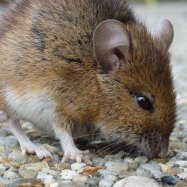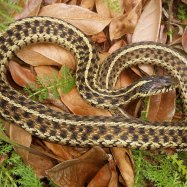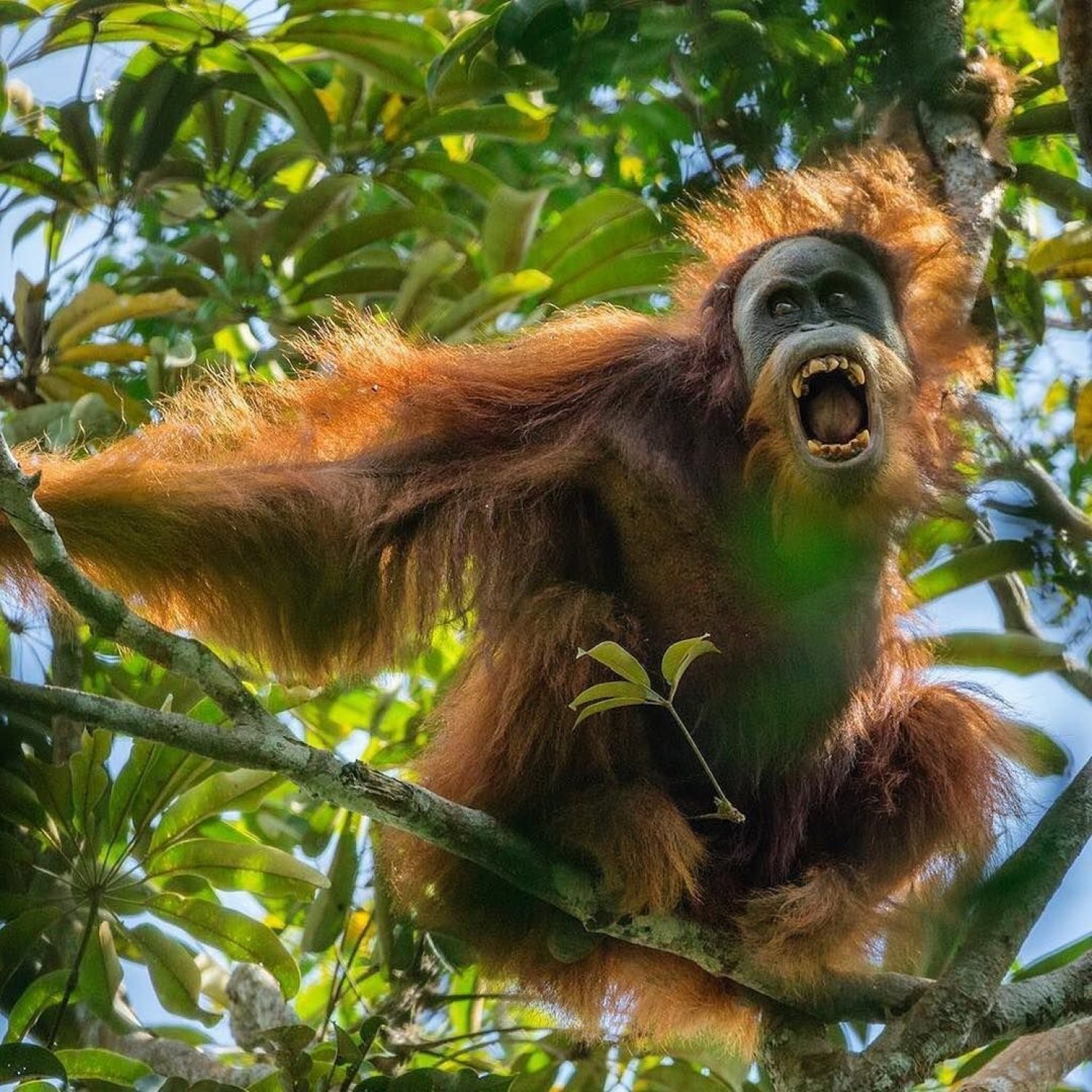
Tapanuli Orangutan
1.2 to 1.5 meters (4 to 5 feet)
Did you know? The Tapanuli Orangutan is one of the rarest and most endangered primates in the world. It is found only in the Tapanuli region of North Sumatra and is known for its distinctive features such as a large and robust body shape. Standing at 1.2 to 1.5 meters tall, this majestic creature belongs to the Hominidae family and is a vital part of the biodiversity in the area. Let's protect and conserve these amazing animals for future generations. #TapanuliOrangutan #EndangeredSpecies #NorthSumatra #Biodiversity
Animal Details Summary:
Common Name: Tapanuli Orangutan
Kingdom: Animalia
Habitat: Rainforests
The Tapanuli Orangutan: A Majestic and Endangered Species
The Tapanuli Orangutan, also known as Pongo tapanuliensis, is a remarkable primate species found in the rainforests of the Tapanuli region in North Sumatra, Indonesia. It is one of the rarest and most endangered species of orangutans, with an estimated population of only about 800 individuals left in the wild. It was only recently discovered in 2017, making it one of the newest additions to the great ape family.The Tapanuli Orangutan shares many similarities with its Bornean and Sumatran cousins, but it also has distinct physical and behavioral characteristics that make it stand out Tapanuli Orangutan. Its scientific name, Pongo tapanuliensis, was given to honor the Tapanuli region where it was first discovered. This magnificent creature has captured the hearts of many researchers and conservationists, and they are working relentlessly to protect and preserve its diminishing population.
The Taxonomy of the Tapanuli Orangutan
The taxonomy of the Tapanuli Orangutan places it in the Animalia kingdom, Chordata phylum, Mammalia class, Primates order, and Hominidae family. It is one of the three species of orangutans, along with the Bornean orangutan (Pongo pygmaeus) and the Sumatran orangutan (Pongo abelii). The Tapanuli Orangutan is the most genetically distinct of the three, enough to be classified as a separate species.The Incredible Habitat of the Tapanuli Orangutan
The Tapanuli Orangutan inhabits the fragmented forests of the Tapanuli region in North Sumatra, Indonesia. Its habitat consists of tropical rainforests, with a diverse range of flora and fauna. These rainforests are rich in vegetation, with a canopy of towering trees that provide the perfect home for the orangutans. They also have access to a steady supply of fruits, leaves, and other plant materials that make up their herbivorous diet Turkey.Unfortunately, the rapid expansion of human settlements and agriculture has resulted in the destruction of the Tapanuli Orangutan's habitat. The conversion of forests into palm oil plantations and illegal logging has severely impacted their population and pushed them to the brink of extinction.
The Herbivorous Diet of the Tapanuli Orangutan
Being a primate, the Tapanuli Orangutan's diet mainly consists of fruits, leaves, and other plant materials. They have also been known to consume tree bark, termites, and insects. Unlike other primates, they have not been observed eating meat or vertebrates. The diverse range of fruits they consume also makes up their water intake, reducing their reliance on external water sources.The Tapanuli Orangutan's diet plays a crucial role in maintaining the balance of the rainforest ecosystem. As they travel through the forest, they disperse seeds and aid in the growth and regeneration of plants, helping to ensure the survival of their habitat.
The Geographical Distribution of the Tapanuli Orangutan
The Tapanuli Orangutan was first discovered in the Batang Toru Ecosystem, a remote region in the Tapanuli district of North Sumatra, Indonesia. Its distribution is limited to this specific area, making it one of the rarest primates in the world. The dense forests of Batang Toru provide the perfect cover for their survival, away from human interference.The Endangered Status of the Tapanuli Orangutan
The Tapanuli Orangutan is listed as Critically Endangered on the IUCN Red List, facing a high risk of extinction in the near future. Its population has drastically decreased in recent years due to habitat loss, hunting, and disease. The Tapanuli Orangutan is facing numerous threats, making it one of the most vulnerable primate species.The conversion of forests into palm oil plantations is the most significant threat to the Tapanuli Orangutan's survival. The destruction of their habitat has resulted in the isolation and fragmentation of their population, making it difficult for them to find suitable mates and maintain genetic diversity. Human activities, such as hunting and capture for the illegal pet trade, also add to their declining numbers.
The Physical Appearance of the Tapanuli Orangutan
The Tapanuli Orangutan has a unique appearance compared to its Bornean and Sumatran counterparts. It has a dark brown to black fur, with distinct facial features, such as a prominent brow ridge and large cheek pads. Their hair is longer and shaggier than other orangutan species, giving them a more rugged appearance.They have a large and robust body shape, with males weighing around 90 kilograms (200 pounds) and females around 50 kilograms (110 pounds). They have long, powerful arms that can stretch up to two meters, making it easier for them to traverse through the tree canopy.
The Social Behavior of the Tapanuli Orangutan
The Tapanuli Orangutan is a solitary animal, with males and females only coming together during the mating season. They are arboreal creatures, spending most of their time in the trees. They are slow-moving and prefer to stay in one area for an extended period, building nests for shelter and sleeping.These intelligent primates also display complex behaviors, such as using tools. Researchers have observed them using tree branches to extract insects from tree holes, showing their ability to innovate and problem solve.
The Role of Conservation Efforts in Protecting the Tapanuli Orangutan
The Tapanuli Orangutan's dwindling numbers have raised alarm among conservationists, who are working tirelessly to protect and preserve this endangered species. Conservation organizations, such as the Sumatran Orangutan Conservation Programme (SOCP), are actively involved in habitat protection, conservation education, and rehabilitation programs for rescued orangutans.In addition to efforts to protect their habitat, initiatives have also been taken to reduce human-wildlife conflict by promoting sustainable practices and alternative livelihoods for local communities. Strict laws have also been enforced to prevent hunting and capture of these primates, and sanctions have been imposed on companies involved in illegal activities that harm their habitat.
Conclusion
The Tapanuli Orangutan is a fascinating and critically endangered species that deserves our utmost attention and protection. Its unique physical and behavioral characteristics set it apart from other orangutan species and make it a crucial member of the rainforest ecosystem. It is imperative that we take action to protect their habitat and ensure their survival for future generations to appreciate and cherish. Let us work together to save the Tapanuli Orangutan from the brink of extinction.

Tapanuli Orangutan
Animal Details Tapanuli Orangutan - Scientific Name: Pongo tapanuliensis
- Category: Animals T
- Scientific Name: Pongo tapanuliensis
- Common Name: Tapanuli Orangutan
- Kingdom: Animalia
- Phylum: Chordata
- Class: Mammalia
- Order: Primates
- Family: Hominidae
- Habitat: Rainforests
- Feeding Method: Herbivorous
- Geographical Distribution: Tapanuli region of North Sumatra, Indonesia
- Country of Origin: Indonesia
- Location: Tapanuli region of North Sumatra
- Animal Coloration: Dark brown to black
- Body Shape: Large and robust
- Length: 1.2 to 1.5 meters (4 to 5 feet)
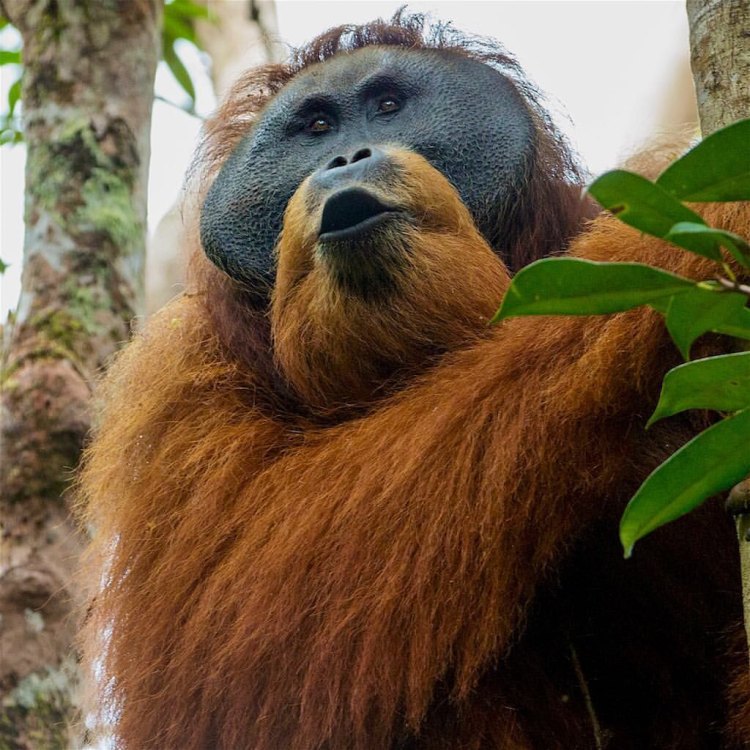
Tapanuli Orangutan
- Adult Size: Large
- Average Lifespan: Approximately 50 years
- Reproduction: Sexual
- Reproductive Behavior: Polygamous
- Sound or Call: Long calls
- Migration Pattern: Non-migratory
- Social Groups: Solitary or small groups
- Behavior: Arboreal and diurnal
- Threats: Habitat loss, hunting, and illegal pet trade
- Conservation Status: Critically Endangered
- Impact on Ecosystem: Seed dispersers
- Human Use: Tourist attraction and research
- Distinctive Features: Prominent cheek flanges in adult males
- Interesting Facts: Discovered as a separate orangutan species in 2017
- Predator: Tigers and other large predators
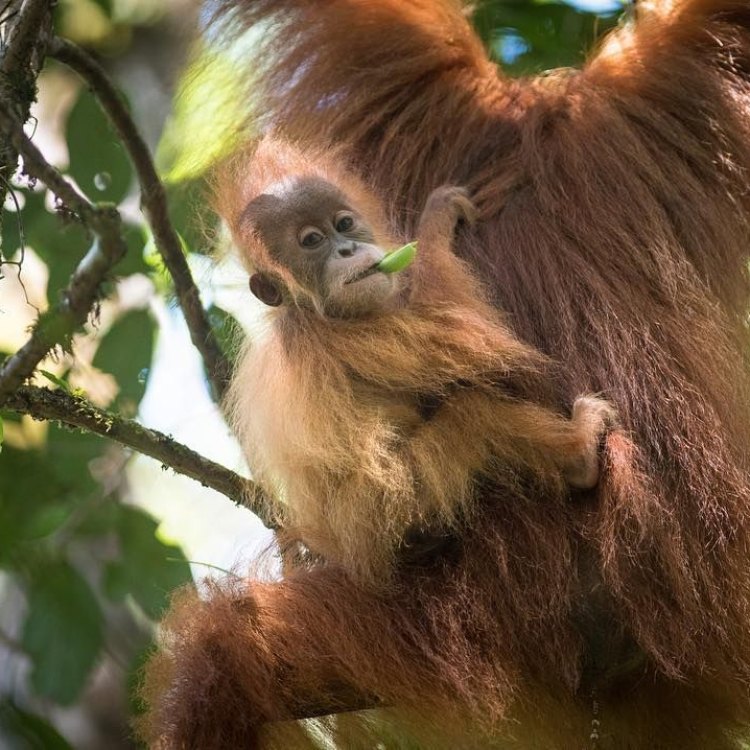
Pongo tapanuliensis
The Fascinating Tapanuli Orangutan: A Critically Endangered Species
The rainforests of Indonesia are home to a unique and endangered species of orangutan - the Tapanuli Orangutan. Discovered in 2017, this species is the latest addition to the family of great apes, and it has already captured the hearts of many with its distinctive features and fascinating behavior.Native to the Batang Toru forest in North Sumatra, the Tapanuli Orangutan (Pongo tapanuliensis) is the rarest of all great apes, with an estimated population of less than 800 individuals. Its discovery has been hailed as a significant scientific breakthrough, as before 2017, it was believed that there were only two existing species of orangutans - the Sumatran and Bornean orangutans PeaceOfAnimals.Com.
The Tapanuli Orangutan has several unique features that set it apart from its cousins. As an adult, it is the largest of all orangutan species, reaching a height of 3-5 feet and weighing between 150-200 pounds. It is also the only orangutan species with prominent cheek flanges in adult males. These flanges, which can reach up to 3 inches in size, play a vital role in mating and attracting mates.
Like all orangutans, the Tapanuli Orangutan is known for its intelligence and arboreal nature. It is primarily an arboreal species, spending most of its life in trees, and has adapted to its forest habitat through unique physical capabilities. Their long arms and strong hands allow them to move effortlessly through the trees, and their curved fingers and toes help them grip branches with ease.
Another distinctive feature of the Tapanuli Orangutan is its long call, which can last up to 5 minutes and can be heard up to 1.2 miles away Termite. These long calls are used by males to establish dominance and attract mates. This form of communication is crucial for the survival of the species, as they are solitary or live in small groups. Due to their low population and fragmented habitat, it is rare for individuals to interact with one another.
The Tapanuli Orangutan is also the only great ape with a non-migratory pattern. Unlike other orangutan species that move from one area to another in search of food, water, or better habitat, the Tapanuli Orangutan stays within a limited range of 2-3 square miles throughout its life. This behavior is essential for conservation efforts, as it makes it easier to track and protect their population.
Reproduction for the Tapanuli Orangutan is similar to their cousins, with sexual reproduction and polygamous behavior. Females will only give birth once every 8-9 years, with a gestation period of approximately 8 months. Mothers care for their young for the first 6-7 years of their life, teaching them crucial survival skills and ensuring their safety.
The average lifespan of a Tapanuli Orangutan is approximately 50 years, with the oldest recorded individual living up to 50 years. Like other great apes, they are slow reproducers, making them vulnerable to threats such as habitat loss and hunting.
Habitat loss is the most significant threat to the survival of Tapanuli Orangutans. Their forest home has been reduced by 60% in the past 35 years due to logging, plantations, and infrastructure development. This habitat loss not only affects the orangutans but also has a significant impact on the ecosystem as a whole.
As an arboreal species, the Tapanuli Orangutan plays a crucial role in seed dispersal, helping to regenerate and maintain the health of the forests they inhabit. Without them, the ecological balance could be disrupted, leading to cascading effects on other species.
Another threat to the Tapanuli Orangutan is hunting and illegal pet trade. While hunting orangutans is prohibited in Indonesia, it still occurs, mainly due to human-wildlife conflict and the demand for their meat and body parts for traditional medicine. Additionally, babies are often taken from their mothers and sold as pets, causing harm to the individual and further reducing the population.
Due to these threats, the Tapanuli Orangutan has been classified as Critically Endangered on the IUCN Red List. This status means that the species faces an extremely high risk of extinction in the wild if urgent conservation measures are not taken.
Efforts are being made to protect and conserve the Tapanuli Orangutan. The Indonesian government has established a conservation area in Batang Toru and is working with local communities to raise awareness and promote sustainable living practices. Several non-governmental organizations are also involved in research and conservation efforts to better understand and protect this rare species.
Aside from the vital role they play in the ecosystem, the Tapanuli Orangutan also has economic and cultural value. The Batang Toru forest is a popular tourist destination, and the presence of this unique species has become a significant attraction. Additionally, researchers are studying these great apes to learn more about their behavior, which can provide valuable insights for the study of human evolution.
In conclusion, the Tapanuli Orangutan is a remarkable species that stands out in the animal kingdom for its distinctive features, behavior, and status as a critically endangered species. Its discovery in 2017 was a significant scientific achievement, and it is crucial that we take immediate action to protect and conserve this rare and fascinating species. By doing so, we not only ensure the survival of the Tapanuli Orangutan but also contribute to the maintenance of a healthy and diverse ecosystem.
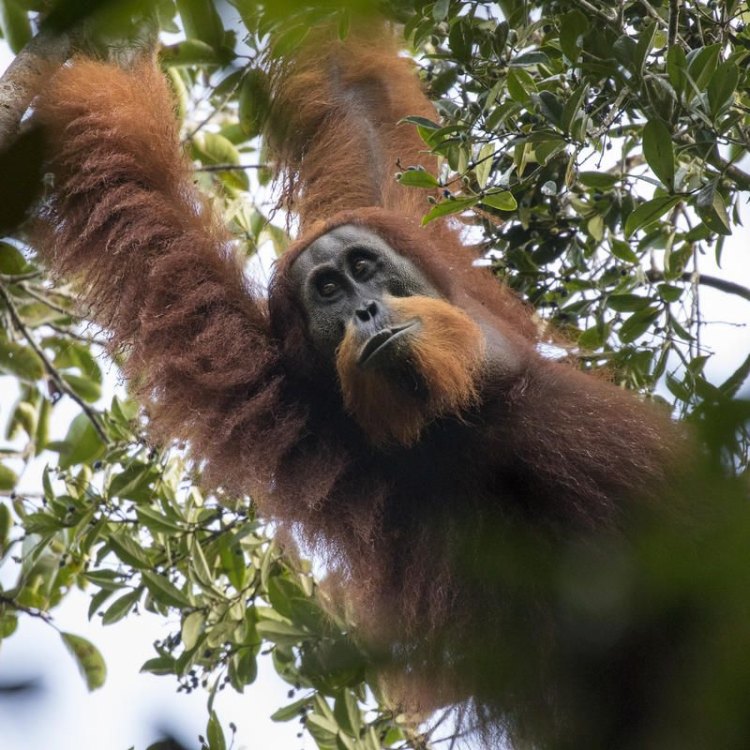
The Tapanuli Orangutan: A Majestic and Endangered Species
Disclaimer: The content provided is for informational purposes only. We cannot guarantee the accuracy of the information on this page 100%. All information provided here may change without prior notice.

